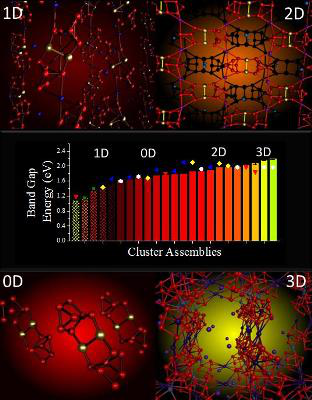Jul 3 2013
The ultimate dream come true for material scientists is to have the ability to make materials that can take on properties and behaviors to best suit our needs. New materials could provide efficient ways to capture solar energy and help us significantly advance the way motors, generators and other devices critical to improving our energy needs are made.
 Cluster assembled materials with zero to three dimensional architectures, and the background color corresponds to the band gap energy of the material. The center graph shows the band gap energy of 23 cluster assembled materials synthesized in the study with the color corresponding to the band gap energy of the material. Image courtesy of Arthur Reber Ph.D./VCU.
Cluster assembled materials with zero to three dimensional architectures, and the background color corresponds to the band gap energy of the material. The center graph shows the band gap energy of 23 cluster assembled materials synthesized in the study with the color corresponding to the band gap energy of the material. Image courtesy of Arthur Reber Ph.D./VCU.
But scientists first must truly understand the properties of cluster assembly through the individual cluster. However, it’s a bit like trying to decipher a symphony by only listening to the percussion. That’s been the conundrum in moving the field forward.
Now, thanks to the work of a team of scientists from Virginia Commonwealth University, Pennsylvania State University and the University of California, Los Angeles, material scientists will have greater insight into the organizing principles that allow for the design of nanoscopic materials with specific band gap energy. Band gap energy refers to the minimum energy of light that the material may absorb.
Cluster-assembled materials are solids that are constructed from clusters – small nanoparticles of a few to a few dozen atoms. By fabricating these materials with different links, the assembly can be made into separated clusters, chains of clusters, sheets of clusters and three-dimensional lattices of clusters. By changing these linkers, the lowest energy color of light the material can absorb may be changed from deep in the infrared to green.
This research explains how the linkers interact with the cluster and what determines the color of the material.
“The findings help fulfill the ultimate dream in material science, namely, the ability to synthesize novel materials that did not already exist in nature that can perform functions to satisfy our growing needs,” said lead investigator Shiv N. Khanna, Ph.D., professor in the Department of Physics in the VCU College of Humanities and Sciences.
According to Khanna, developing a material with the appropriate band gap that will absorb multiple wavelengths will maximize the efficiency at which the solar energy can be absorbed. Sunlight covers a wide range of wavelengths with the maximum energy wavelength of about 4950 Å.
“The principles developed through the current study offer a general approach for the synthesis of materials with controllable functionalities,” said Arthur Reber, Ph.D., research associate professor in the VCU Department of Physics, who collaborated on the study with Khanna.
“As an example, we have just shown how novel magnetic solids can be synthesized by assembling chosen nanoparticles. These solids have potential applications in motors, generators and other devices critical to energy needs,” said Khanna.
The team is now further developing their ideas to demonstrate applications in optical, catalytic and magnetic materials.
The scientists conducted a series of theoretical calculations and first principles electronic structure investigations, collected X-ray data and performed computer modeling.
The study was recently published in Accounts of Chemical Research, a journal of the American Chemical Society. The study is titled, “Controlling the Band Gap Energy of Cluster-Assembled Materials.”
This research was supported by the U.S. Department of the Army, Army Research Office (AFOSR), through MURI Grant W911NF-06-1-0280 and MURI Grant No. FA9550-08-1-0400.